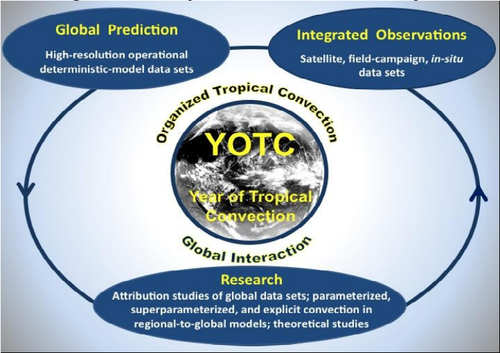
|

|
|
Climate: Understanding, assessing, predicting, mitigating, and adapting to climate variability and changeYear of Tropical Convection (YOTC): A Virtual Global Field CampaignThe ChallengeCoordinated jointly by the WCRP and WWRP/THORPEX, the Year of Tropical Convection (YOTC) project recognizes that within the 10-year implementation of GEOSS, a paradigm change is needed in how the tropics are represented in climate models. As a fundamental element of Earth-system science of societal relevance, tropical convection is organized into complex multi-scale precipitation systems that are building blocks of high-impact meteorological events. Directly or indirectly, these events affect a huge percentage of the world’s population. The motivation, science, and implementation are available at www.ucar.edu/yotc. Much of the uncertainty associated with weather and climate derives from our incomplete understanding of how the meteorological scales at the intersection of weather and climate – the mesoscale (10-100 km), synoptic (1000 km), and planetary – interact with each other. This complicates our attempts to predict high-impact phenomena associated with the tropical atmosphere, such as the monsoons and tropical cyclones. These and other phenomena influence the weather and climate of the mid- and high-latitudes through the migration of weather systems out of the tropics or through the effects of tropical convection on the atmospheric circulation that extend to, or strongly influence, the extra-tropics by planetary-wave telecommunication. It will be impossible to predict climate on regional scales or to comprehend the variability of the global water cycle in a warmer world without comprehensively addressing tropical convection and its interactions across time and space scales. A creative application of the global integrated Earth observation, numerical computation and theory, the YOTC project addresses most of the objectives in the GEOSS paper. That includes international integration, cross-cutting, and inter-agency collaboration and involves in-situ, airborne, and space-based observations; data integration and information fusion; the effective use of global and regional products; and fundamental research. The YOTC project addresses the Climate, Weather, and Water Societal Benefit Areas (SBAs) of GEOSS, and has relevance to its Agriculture and Disasters SBAs. YOTC is a key element of the seamless prediction of weather and climate (a GEO priority) and is aligned with WCRP's GEWEX and CLIVAR programs. As task CL-09-01a of the GEO Work Plan, it is fully integrated with GEO's objectives and societal benefit areas. The YOTC project utilizes resources in an entirely new integrative way in the form of a virtual global field campaign. "Virtual" means that the atmosphere and its variability are not sampled through a new, specialized and costly field campaign, but instead are represented by a variety of available, yet relatively new, state-of-the-art resources. Advantages of the virtual approach include cost effectiveness and flexibility. It is cost effective because the data already exist in operational weather centers and via satellite data centers. It is flexible because the virtual database can progressively be improved as new data-assimilation methods become on-stream, new data sources are incorporated in the data-assimilation methods, satellite retrieval algorithms are improved, models attain higher resolution, and physical parameterizations improve. The YOTC research component is focused on complex meteorological phenomena that are long-standing challenges for weather and climate models, e.g., the monsoons, tropical intraseasonal variability, easterly waves and tropical cyclones, and tropical-extratropical interaction. The above three-pronged approach is illustrated in the figure below. The European Centre for Medium-Range Weather Forecasts (ECMWF) in Reading, UK, already has provided a virtual database (25-km mesh) for the "Year," namely May 2008 - April 2010. The US National Centers for Environmental Prediction (NCEP) and the NASA Global Modeling and Assimilation Office (GMAO) also are engaged, and other prediction centers are expected to join. A satellite data dissemination system, based on the Giovanni methodology initially developed at NASA Goddard has been adapted for multi-platform usage. These data are freely available to the community. |
Figure 1. Components of the YOTC Project. YOTC consists of three integrated components: i) Global weather prediction models provide high-resolution global analysis, forecasts, and physical process tendencies; ii) integrated observations include multi-sensor satellite, in-situ, and field campaign data; and iii) research. Research involves diagnostic studies of models and observations, cloud-system resolving models, and theory. The focus is on complex multi-scale phenomena that represent long-standing challenges for weather and climate models: monsoons, tropical intraseasonal variability, easterly waves and tropical cyclones, and tropical-extratropical interaction. Download the YOCT Flyer. See full documentation at www.ucar.edu/yotc. For more information contact: Dr. Mitchell W. Moncrieff, National Center for Atmospheric Research (NCAR)1, 1850 Table Mesa Drive, Boulder, Colorado 80305, USA (moncrief@ucar.edu). |
